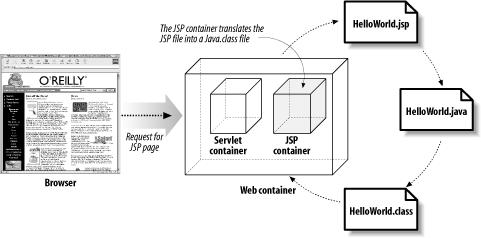The first thing to understand about JavaServer Pages is that it’s a natural extension to the Java Servlet technology. In fact, after some preprocessing by a translator, JSP pages end up being nothing more than Java servlets. This is a point that many beginning developers have a hard time understanding. JSP pages are text documents that have a .jsp extension and contain a combination of static HTML and XML-like tags and scriptlets. The tags and scriptlets encapsulate the logic that generates the content for the pages. The .jsp files are preprocessed and turned into .java files. At this point, a Java compiler compiles the source and creates a .class file that can be executed by a servlet container.
The translator that turns the .jsp file into a .java file takes care of the tedious work of creating a Java servlet from the JSP page. Figure 1-2 illustrates how a JSP page is translated and compiled into a servlet.
JSP technology has become an extremely popular solution for building web applications using the Java platform. JSP offers several advantages over its competitors:
JSP is a specification, not a product. Developers are able to choose a “best of breed” approach.
JSP pages are compiled, not interpreted, which can lead to better performance.
JSP pages support both scripting and access to the full Java language and can be extended through the use of custom tags.
JSP pages share the Write Once, Run Anywhere™ characteristics of Java technology.
As mentioned in the previous section, one of the limitations of using hardcoded HTML inside of servlets is the problem of separating page design and application logic programming responsibilities. This separation is easier with JSP pages, because the HTML designers are free to create web pages with whatever tools they choose (many of today’s popular tools are capable of working with JSP and custom tags). When they are comfortable with the page layout, the JSP developers can insert JSP scriptlets and custom tags and save the files with a .jsp extension. That’s pretty much all there is to it. When the time comes to change either the page layout or page logic, the developer modifies the JSP page as needed and allows it to be recompiled automatically.
Together, JSP pages and servlets are an attractive alternative to other types of dynamic web programming. Because both are based on the Java language, they offer platform-independence, extensibility into the enterprise, and, most importantly, ease of development.
Get Programming Jakarta Struts, Second Edition now with the O’Reilly learning platform.
O’Reilly members experience books, live events, courses curated by job role, and more from O’Reilly and nearly 200 top publishers.


